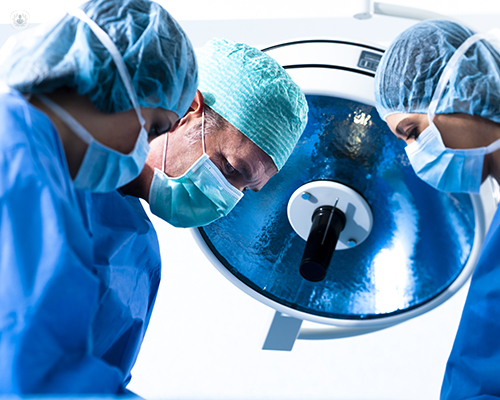An expert’s guide to gallstone surgery
Escrito por:Gallstones are small stone-like particles that form in the gallbladder from bile cholesterol and bilirubin. They are solid and can lead to problems if they become stuck in the wrong position. We interviewed expert surgeon Mr Zak Rahman, who explained gallstones and surgery to remove them.

What are the symptoms of gallstones?
Gallstones are very common. It's estimated that about 10-15% of the population will develop gallstones at some point in their life. However, the important thing to remember about gallstones is that most gallstones do not cause any symptoms.
Of all the people that develop gallstone-related problems, about 10% will become symptomatic. Patients may develop pain – usually after eating – which may not necessarily require hospitalisation. In more severe cases, the patient may end up in hospital and require antibiotics because the gallbladder has become infected or inflamed.
There are other complications of gallstones. The gallstone might drop out of the gallbladder and enter a big channel which connects the liver to the food pipe and you can get serious complications in terms of pancreatitis and blockage of the bile, where patients become jaundiced.
When is surgery for gallstones considered?
Patients require surgery if they have symptomatic gallstone disease. This basically means they have pain, which is related to eating, or they develop complications like acute cholecystitis, chronic cholecystitis, where you've got long-term scarring, or complications associated with a stone popping into the duct and irritating the glands or causing a blockage that leads to jaundice.
What can I expect during the operation?
Once patients are admitted, they have usually undergone a pre-assessment process. They're prepared for theatre and essentially, we've asked patients not to eat anything for approximately six hours for solid food and about four hours for liquid food.
When they arrive, they are provided with an information sheet and the surgeon who is treating them explains the risks and benefits of the surgery. Once they have signed and consented, they then enter theatre, where a final check is performed to make sure that the operation is indicated and the various governance aspects that we take fairly strongly here at the Royal Free. Then the operation begins.
The operation itself involves keyhole surgery (minimal access surgery). Four small holes are created in the abdominal wall. The first hole is created just below the level of the belly button, and this allows the introduction of carbon dioxide, which is harmless to us as we breathe it out all the time. The gas enters the tummy cavity and that allows us to see what we're doing and also gives us space to operate in. Once the gas fills the abdominal cavity, we then introduce three other small instruments and those are working instruments to allow the operation to take place.
In its simplest terms, the operation involves the removal of the gallbladder from the bottom end of the liver. The gallbladder is attached by the cystic duct, which is bit of plumbing to allow the juices made by the gallbladder to mix with food, and also by a small blood vessel which supplies the gallbladder and keeps you alive. Usually, we clip off the duct and the artery and then remove the gallbladder (which is loosely attached to the bottom end of the liver) using something called diathermy (heat energy). The gallbladder is then put into a bag and then taken out through the hole around your belly button, and then the holes are subsequently closed up.
Often, the gallbladder is very inflamed and about 5% of patients require a conversion procedure, i.e. we may start off with keyhole surgery and either due to complications during the operation, which are very rare, or the gallbladder being so stuck down that we can't tell the anatomy of it, we may convert to an open procedure, i.e. an incision at the bottom end of the ribcage. Unfortunately, that means that the hospital stay is going to be a little bit longer (usually about five days), because more pain relief is required.
Our day-case rates approach about 99% here at Hadley Wood. Most patients are home within five and a half hours.
What happens after having my gallbladder removed?
The reason for gallbladder surgery is to reduce the pain and also to allow you to return to a normal diet. It's important to remember that there is a lot of crossover of symptoms, particularly among women. About 5-10% of patients may have bowel-related problems called irritable bowel syndrome, and the gallbladder, as we discussed before, may not necessarily be causing your symptoms. It's very important to get the correct assessment by a specialist hepatobiliary surgeon in the first instance.
After the operations, patients usually recover very quickly, and what we want the patients to do is to return to a normal lifestyle, pain-free and eating and drinking what they want. What’s more, the bile continues to flow. The gallbladder itself is just a storage sac, so there is no long-term harm of having your gallbladder taken out.
Why is it important to see a gallbladder specialist?
Most gallbladders are taken out by general surgeons; however as a HPB specialist, I deal specifically with liver, pancreas and gallstone disease, and we often see the tail end of the problems or very complicated decisions in terms of removing gall bladders. It's an assessment which is done at the time of the operation, and often gallbladders can be so inflamed that they may cause problems with the liver or the bile ducts. I would urge most patients who have complicated gallbladder disease to see a specialist surgeon.


